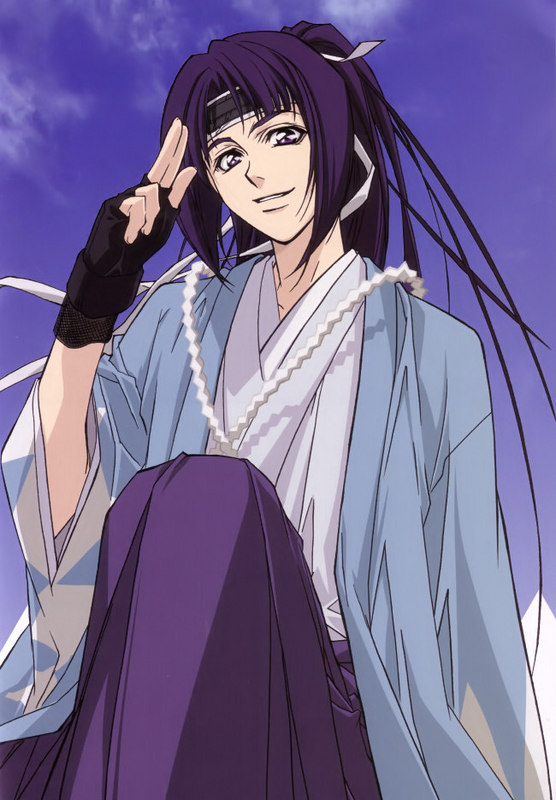Okita Sōji (沖田 総司), (1842 or 1844 - July 19, 1868) was the captain of the first unit of the Shinsengumi, a special police force in Kyoto during the late shogunate period. He was a well-known genius swordsman, being one of the best swordsmen of the Shinsengumi, along with Saito Hajime and Nagakura Shinpachi.
Background
He was born Okita Sōjirō Fujiwara no Harumasa in 1842 or 1844 from a samurai family in the Shirakawa Domain's Edo mansion. His great-grandfather was Okita Kan'emon (? - 1819) and his grandfather was Okita Sanshiro (? - 1833.) His father, Okita Katsujiro, died in 1845; he had two older sisters, Okita Mitsu (1833-1907) and Okita Kin (1836-1908.) In 1846, in order to marry the adopted son of the Okita family, Okita Rintaro (1826-1883), his oldest sister Okita Mitsu became an adopted daughter of Kondo Shusuke in name. Kondo Shusuke was the third master of the Tennen Rishin Ryu and Okita started training at the Shieikan with him around the age of nine. By that time, Kondo Shusuke had already adopted Shimazaki Katsuta (the later Kondo Isami), but Hijikata Toshizo had not yet enrolled at the Tennen Rishin-ryu school. Okita proved to be a prodigy; he mastered all the techniques and attained the Menkyo Kaiden scroll (license of total transmission) in the ryu at the age of eighteen or so
In 1861, Okita became the Head Coach (Jukutou) at the Shieikan. Even though he was often commented to be honest, polite, and good-natured by those around him, he was also known to be a strict and quick-tempered teacher to his students.
Days in the Shinsengumi
Okita changed his name to Okita Souji Fujiwara no Kaneyoshi some time before his departure to Kyoto in 1863. He soon became a founding member of the Shinsengumi and a Fukuchou Jokin (Vice-Commander's Assistant.) Okita Rintarou, also a practitioner of the Tennen Rishin-ryu, became a commander of the Shinchougumi (the Shinsengumi's brother league in Edo.)
Okita was the second youngest among the Shieikan members, most likely with Todo Heisuke being the youngest. He was one of the Shieikan members involved in the Serizawa Kamo (one of the original commanders of the Shinsengumi) and the Uchiyama Hikojiro assassinations in 1863.
Equally skilled with shinai, bokken/bokutou, and katana, his signature technique was named the Mumyo-ken (which roughly translates as "no light blade") or Sandanzuki (which translates as "Three Piece Thrust"), a technique that could attack one's neck, left shoulder, and right shoulder with one strike. (the Mumyo-ken supposedly could hit all three points simultaneously, but this is most likely an embellishment.) The Mumyo-ken was his own invention and it could have been derived from an invention of Hijikata's (the Hirazuki.)
It was rumored that his tuberculosis was discovered when he coughed blood and fainted during the Ikedaya Affair, but some sources say that he contracted the disease after that. Both are reasonable, as tuberculosis can kill quickly (weeks), or very slowly (many years). While many of the Shinsengumi fans believe that Yoshida Toshimaru was killed by Okita during the Ikedaya Affair (based on Shimosawa Kan and Shiba Ryoutarou's fiction), it is in fact historically inaccurate.
Based on Shiba Ryoutarou's fiction, many also believe that Okita and Hijikata were like brothers. In history, Yamanami Keisuke was the vice-commander Okita shared a brotherly relationship with. Yamanami's seppuku (with Okita as his second) in 1865 was an extremely painful incident in Okita's short life. There is no record showing that Hijikata and Okita were close; it is debatable whether Okita even got along with Hijikata.
In 1865, Okita became the captain of the first unit of the Shinsengumi and also served as a kenjutsu instructor; later that year, he was appointed by Kondo Isami to be the fifth master of the Tennen Rishin-ryu after him.
Although highly unlikely, it was rumored that he wielded a famous katana called Kikuichi-monji. However, he surely owned a set of Kaga Kiyomitsu (a katana and a wakizashi) and his so-called "Kikuichimonji Norimune" was likely a Yamasiro Kunikiyo instead.
Death
During the Boshin War, after the Battle of Toba-Fushimi in January of Keiō 4, Okita went into Matsumoto Ryōjun's hospital in Edo. He then moved to a guesthouse with Okita Rintarou, Okita Mitsu, and their children. When the shogunate forces (including the Shinsengumi and the Shinchōgumi) retreated to the Tohoku region, Okita remained in Edo alone. He died from tuberculosis on July 19 (lunar calendar May 30th), 1868. Later that night, he was buried at his family temple in Edo (present Tokyo), under his birth name (with Okita Souji listed in the death records.) Today, Okita's grave is not open to the public.[16]
The information that Okita died when he was 25 is based on the theory that he was born in 1844 and therefore was 25 by East Asian age reckoning when he died in 1868.
Anime and Manga
Most easily recognized in the shows Peacemaker Kurogane and Rurouni Kenshin (Samurai X). And also most often portrayed as a bishounen, tall, thin, long hair, and a little feminine.

All this information was gathered at Wikipedia, for more, go here.